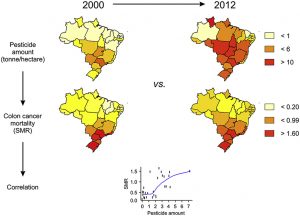Agriculture is the largest sector within the Brazilian economy, and the tropical nation is now the largest pesticide consumer worldwide.
Research recently published in the peer-reviewed journal Chemosphere explores whether rising pesticide use is driving dramatic, recent increases in the rate of colon cancer cases in many parts of Brazil.
This epidemiology study used pesticide use databases from the Brazilian Institute of Environment and Renewable Natural Resources and cancer mortality data from the Ministry of Health to see if there was a correlation between the two factors.
Their results, summarized in the graphic below, show that trends in pesticide sales correlated with increased colon cancer mortality rates, particularly in the intensively farmed Southern and Southeastern regions of the country where most of the cultivated cropland is producing GMO soybeans and corn.

Like any other epidemiology study, there are limitations to this research and it provides no help in proving causation. But, hopefully it WILL inspire further research. Herbicide use has been rising in the U.S. for decades, in step with the spread of herbicide-tolerant crops, and suspicions of human health and environmental impacts have risen along with it.
Large-scale, pesticide-intensive GE crops dominate corn, soybean, and cotton production in many countries, including the U.S., Brazil, and Argentina. This new paper joins several others addressing the possible contributions of rising pesticide use and exposures to adverse public health outcomes.
Source:
Martin, F. L., Martinez, E. Z., Stopper, H., Garcia, S. B., Uyemura, S. A., & Kannen, V, “Increased exposure to pesticides and colon cancer: Early evidence in Brazil,” Chemosphere, 2018, 209, 623-631. doi:10.1016/j.chemosphere.2018.06.118. https://www.ncbi.nlm.nih.gov/pubmed/29957523.

